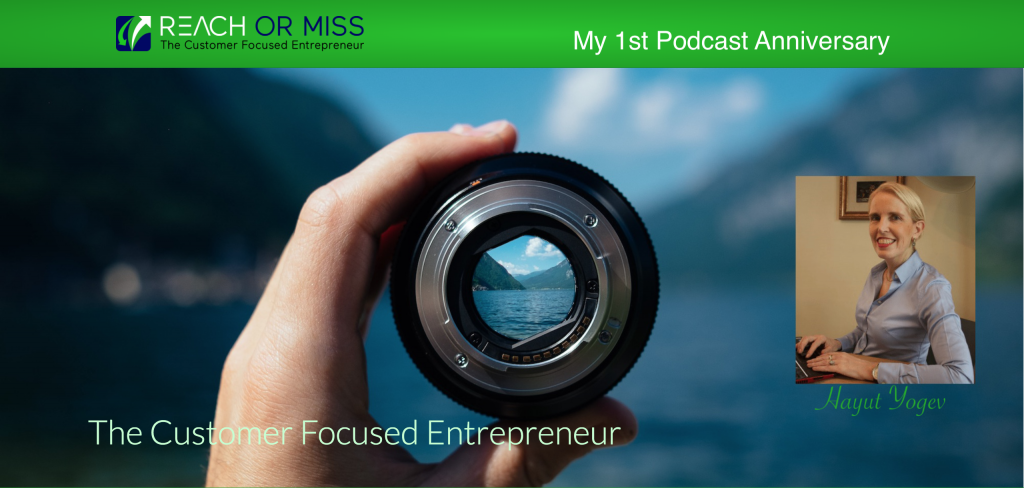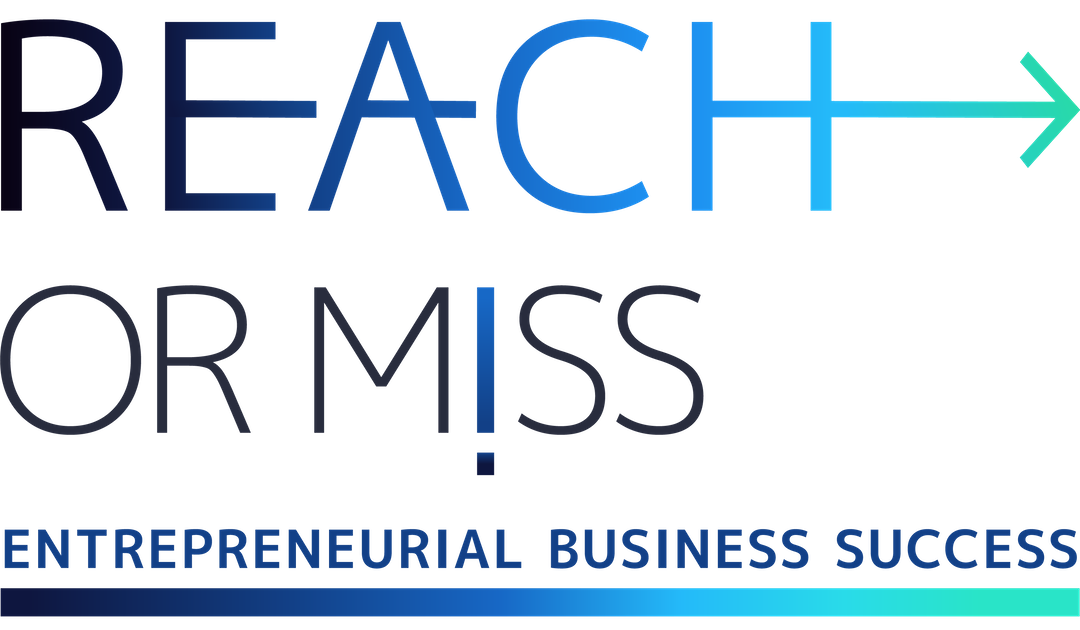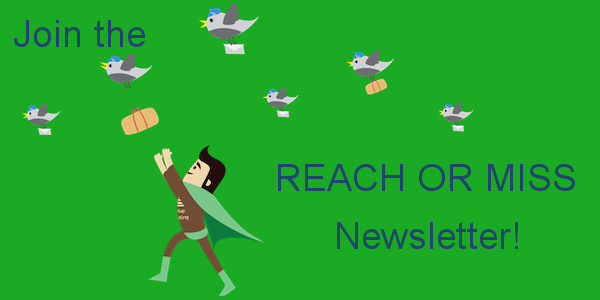Ep. 054 – REACH OR MISS – the truth about the chances of an entrepreneur to succeed

Conclusions from my 1st year of podcasting
This episode is the last and final part of my 1st year anniversary special events.
The issue of entrepreneurial and startups success rate seems to be a major issue. There isn’t a question about the high chances of failure.
Did you ever ask yourself why? 20 years ago, establishing a startup involved trying new and unfamiliar technologies, which had quite a high chance of failing. But today, most of the startups are about new habits or better ways to organize traditional processes. Most of the technology is mature, and it seems like there shouldn’t be such a high percentage of failing startups and entrepreneurial businesses.
Analysts say, at any given moment, 70 people around the world are trying to develop a solution to any specific problem. I can assure you that the one who wins the market won’t be the one with the best technology. Most of them would probably be sufficient. Technologies aren’t a barrier anymore.
The one that will win the market will be the one that manages to drive the most people to use and buy their solution; this is called marketing. As I define it, marketing is about looking at things from the point of view of your potential users, because the money we are looking for is in their pockets.
I started this podcast as part of my mission over the last ten years – to increase the chances for entrepreneurial business success. As hard as I looked, there weren’t enough professional analysis of entrepreneurs’ success rates. This podcast, where I interview successful entrepreneurs weekly, was born in order to help entrepreneurs succeed by learning from other entrepreneurs and finding the patterns that work best.
What are these successful patterns that my interviewees talked about?
It starts with understanding your audience. It’s almost impossible to count the number of times interviewees spoke of the need to really talk with your audience, and to avoid doing things you think, and instead start doing things your audience needs or wants.
Three of the best-known and most successful entrepreneurs, Michael Stelzner, Chris Brogan, and John Lee Dumas used this exact issue as an example of their failures. By the way, each of them tried it after their first big success.
Michael Stelzner, the founder and CEO of the most successful social media blog and conference tried to adopt something that worked in the world of social media to a totally different field:
- I was already very successful, and in my mind I thought well, I will take what I’ve done here and I’ll try it in a new space. And I assumed I would be successful, because I’d done it before.
- I started a project, called My Kid’s Adventures.com and my goal was to create something for parents of young children who were looking to help them do things in a non-digital way… anything that was not a computer screen.
- And it didn’t work! I spent an enormous amount of money on it, it was a huge failure, and this was while Social Media Examiner was exploding. The lesson that I learned from this is that we must stop something to start something. It wasn’t the right time for me to take this project on. I shut it down, but I learned a lot in the process. It was a great learning experience and humbling.
John Lee Dumas wanted to offer a service of establishing a podcast like his most successful podcast for entrepreneurs to others that wanted a podcast of their own:
- This was a huge mistake that I made, and it was a big waste of time energy, effort, and money. It goes back to 2013. A lot of people said they love my podcast and would love to create their own. I wanted to create an entire platform in which I could create other people podcasts for them. I’d host their shows, I’d edit their podcast, I’d create their show notes; I’d do it all. I called it PodPlatform. Everybody that heard the idea said it’s a great product.
- I made all the arrangement and invested and only 1 person signed up for it.
- Luckily it was the perfect number…which let me to realize I don’t want to be in this business; I don’t want to edit other people shows, and upload their outro and intro for them, and host for them. And I went back to this one person, here is your money back, but this is not the kind of business I want to have.
- But I wasted so much time, so much energy and money. And actually I could of said: before I’ll go and create this, and invest so much time and money, let’s have people put money where their mouths are and invest in this product before it exists.
- And I did that a few months later, with Podcaster Paradise, and I had 50 people signed up before we launched, which made me realize that this is something that could actually work. Fast-forward to today, Podcaster’s Paradise has over 3000 members, over 4 million dollars revenue.
Exactly like Mike and John, Chris Brogan tried to create something he thought would be a big success, but didn’t take his own advice to find out who really need it.
- I fail every day! My biggest failures are every time I try to design from my idea or my arrogance or my ego, those usually fail, because I believe that I know best.
- My biggest specific failure, I started a bunch of little private online communities that I thought everyone was going to love – healthcare, nonprofits, real estate, more, and I failed horribly.
- The experience I have had many times is that they developed a product they know how to create, but they haven’t necessarily developed a product that anyone asked for.
Another pattern is the critical issue of changing the attitude from selling to your audience to serving them.
Josh Elledge invented two successful startups, but that only happened after a big failure helped him understand what he needed to do in order to succeed. Join me in listening to Josh’s story about the lesson he learned.
- When I started as an owner of a small town newspaper, I was so uncomfortable with sales. I was so scared that I ended up failing miserably. And after that, for the next five years, I did sales and marketing for a network of law firms and had to sell every day for a commission based salary. I was miserable. One day I realized that it’s not about convincing people to buy, it’s about listening to people needs and discovering how I can help them. In the moment I understood that, I started to enjoy my connection with my clients and began to succeed dramatically. I found the win-win formula.
And my third pattern is about the best ways to promote your product or I probably should say the best ways to not promote your product.
If it’s all about serving your customer and not selling them, if it’s about truly understand what they need and want – don’t promote! Share, advice and answer their questions.
Carla Johnson, told us about educating her customers
- Almost all my guests talked about sharing content and information. Not selling or promoting. That goes back to focus on educating my industry and audience. I started to breaking down the content to small guiding pieces because we want people to do so many things, and they can’t get it all at once.
- And when I started to do these small guiding tips, people started to talk with me about what they needed; this was the foundation for my new book, Experiences: The 7th Era of Marketing.
Jonathan Aufray, who focuses on growth hacking, told us how he connect with customers:
- Most of our customers find us through content we share and what we do in our inbound marketing activities.
- A lot of people are confused about what growth-hacking is. Many entrepreneurs that contact us think that growth-hacking is some cheap way to market where you get millions of customers every day.
- In my opinion, Growth-Hacking is a process. What’s important in growth-hacking is the word growth, not the word hacking. Growth is a process. First of all, you need to know what you want to grow; you need to choose one or two metrics that you want to grow. Is it the number of sales? Is it the number of leads? The amount of traffic to your site or the number of people that will use your product? As I said, you need to choose one or two metrics and focus on those.
- People really don’t understand the focus on growth, they say I have 20000 fans on Facebook, or 20000 people liked me on Instagram, so I ask them, is that where you want to grow, on Instagram? And they answer: No, no, I want sales! So, there isn’t a point of having 20000 likes, unless you want to grow there. You have to focus on your KPI, on your metrics. Once you have the metric, there are many tactics you can use.
And last but not least is Dan Knowlton who explains, we focus on creating as much value, adding content that helps and attracts customers to us, so they come to us and say – we see what you do and we want to work with you.
- I’m passionate about a lot of things, but I think the main one is education, to educate and help people to use the social media strategies we’ve used to grow our business. We are doing it through variety of channels; we create educational content, we use speaking events, and we take part in podcasts, like this. So, what we enjoy and are passionate about is education.
- So for us, the customers we focus on are those who understand the value in what we do, and also those customers that truly understand that this social media, and marketing isn’t a magic pill you take; you are doing one thing and BOOM!! Everything happens. They are those who understand that they need to work hard and they need a team on board etc. Finally, our best customers are customers that share similar values with us, and we have three main values: to have fun, to grow, and make money for both the customers and us, and to live through our values.
I have often written about talking with your customers and not selling them, but I don’t think I’ve written enough about sharing instead of promoting. Think of yourself; how do you look at promoting ads?
I believe that these three patterns will drive your next entrepreneurial business success. I would love to hear your story of attracting potentials customers.
Cheers,
Hayut

